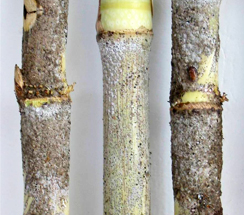
Sugar cane farmers in Uganda are using specially bred beetles to tame the voracious white scale pest that has robbed farmers of any harvest because of their destructive nature on sugar cane.
The innovative mode of scientifically wiping out the pest was discovered and introduced among cane farmers by Dr B. Ramesh an entomologist from Kinyara Sugar factory. The budding scientist who joined the company in 2010 found the pest a major menace in both outgrower and company plantations. “Generally farmers were no longer interested in cane farming due to the losses accruing from the pest and this prompted my quick intervention,” noted Dr Ramesh.
While on field research, the scientist realized an outstanding observation in one of the affected cane. The cane which was affected by white scales had an internodes section that seemed to be clearing up the pests. He took the sugar cane to the laboratory for further analysis and realized that there was a beetle (bio predator) feeding on the pest. According to him, the discovery of a bio predator was a milestone in the fight against the destructive pest. Initially, the company had tried to apply the use of chemical spray which was unhealthy as well as not attainable. “In order to control the white scale using chemicals, the sprayed chemical has to mix with sap in the plant for the pest to suck and eventually die. Ultimately, this means contaminating the cane hence rendering the whole procedure useless,” explained Dr Ramesh.
Related News: Former security guard earns 10× more through sugarcane value addition
Related News: Government directive increases sugarcane buying price by 10%
Out of the 110 days of the life cycle of a beetle, the larvae stage takes about 25-30 days of the cycle period. During this stage, the larvae exclusively feed on the white scales of the sugar cane. Dr Ramesh scientist then embarked on mass rearing of the beetle in order to use them to control the pest. The company gives out grower farmers the bio predator for free as part of their Corporate Social Responsibility.
The larvae are introduced in the sugar cane plantation at an interval of 15 days. Sugar cane cuttings from the laboratory laced with the larvae are introduced at various points of the plantation and the larvae then move into the canes in search of their food which is the sugar cane white scales pest. The larvae feed on the white scales relieving the cane of the menace and offering farmers a lifeline on their investment returns. One hectare of sugar cane plantation is introduced with about 250 grams of beetle larvae.
White scale pests usually establish on internodes covered with leaf sheath. The leaves of infested canes show signs of tip drying and unhealthy pale green colour and with continued infestation turn yellow. Decapping leads to the non-opening of leaves also, which also turns yellow and finally dries out. The nodal region is more infested than the internodal region. In the case of severe infestation, the cane stalks are almost entirely covered by scales. When gravid, the female’s body is 1.8 mm long and 0.9 mm wide.
After egg-laying, the female shrinks and loses her pink colouration. Eggs are laid under the female’s scale. Upon hatching the crawlers which are young immature mobile stage wander looking for a feeding site. They insert their needle-like mouthparts and suck plant sap and do not move again.
Related News: Entrepreneur earns sweet income from sugarcane value addition
The white scale is a serious pest of sugarcane causing yield loss both of canes and sugar content and making extensive replanting necessary. Yield losses of over 30percent percent have been reported in Tanzania while some farmers in the Masindi area had reported 100 percent yield loss prior to the introduction of the bio predators. Infested crops losses their vigour, canes shrivel, growth is stunted and the internodal length is reduced drastically. Ultimately cane dries up. Such canes when slit open appear brownish red. Thus yield and quality suffer. The yield loss could range from negligible to total crop failure.
According to Dr Ranesh, water logging, high temperature and humidity favour the buildup of scale insect population. Rainwater and high wind velocity facilitate the dispersal of the pest. It spreads to new areas through seed material. Men and animals passing through the infested fields also lead to the spread of the pest to the adjoining areas.